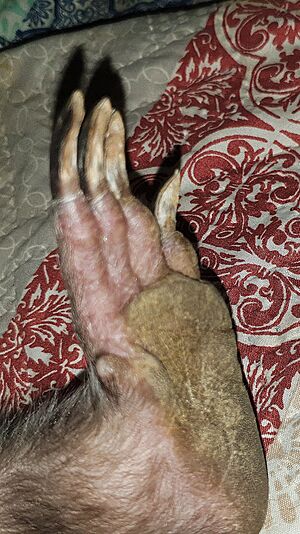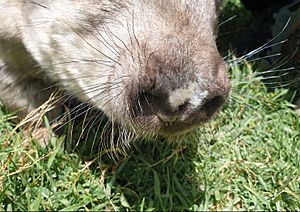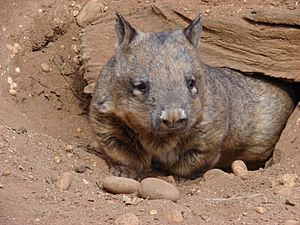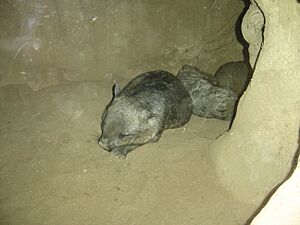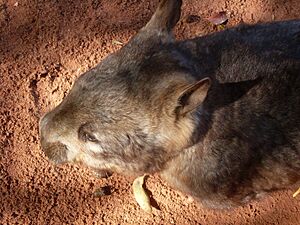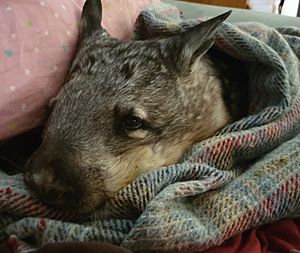Southern hairy-nosed wombat facts for kids
Quick facts for kids Southern hairy-nosed wombat |
|
|---|---|
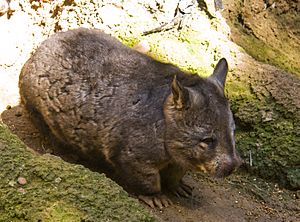 |
|
| Conservation status | |
| Scientific classification | |
| Kingdom: | |
| Phylum: | |
| Class: | |
| Infraclass: | |
| Order: | |
| Family: | |
| Genus: |
Gray, 1863
|
| Species: |
L. latifrons
|
| Binomial name | |
| Lasiorhinus latifrons (Owen, 1845)
|
|
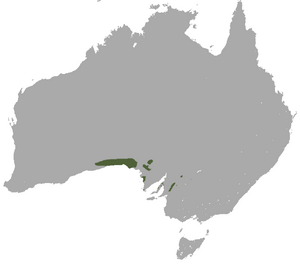 |
|
| Southern hairy-nosed wombat range | |
The southern hairy-nosed wombat (Lasiorhinus latifrons) is one of three types of wombats alive today. You can find it in dry, bushy areas and mallee forests. These areas stretch from the eastern Nullarbor Plain to the New South Wales border. This wombat is the smallest of all three wombat species.
The Southern Hairy-nosed Wombat is a special animal for the state of South Australia. It is their official animal symbol because most of them live there.
Some of the oldest southern hairy-nosed wombats lived in zoos. Carver, a male wombat at Brookfield Zoo near Chicago, lived to be 34 years old. His mother, Vicky, lived to be 24. In South Australia, a pet wombat named Wally also reached 34 years old in 2010. Hamlet, a wombat at the Toronto Zoo, also died at age 34.
Contents
Physical Features of the Southern Hairy-Nosed Wombat
The southern hairy-nosed wombat is built for digging. It has a strong, stocky body and flat claws. It also has five toes on each foot. Its body is about 77 to 93 centimeters (30 to 37 inches) long. It weighs between 19 and 32 kilograms (42 to 71 pounds). Its short tail is hidden by its fur. The fur is soft and usually grey or tan.
Wombats groom themselves using their second and third toes. These toes are joined together, except at the very tips.
Its head is strong and flat, and its ears are pointed. The snout looks a bit like a pig's nose. The animal gets its name from the hairs that cover its snout.
The wombat's front teeth are like those of rodents. Its back teeth (molars) are spaced far apart. These teeth keep growing throughout the wombat's life. This helps them deal with their tough diet.
Female wombats have a pouch that opens backwards, towards their rear. This is very clever! It stops dirt from getting into the pouch when the wombat is digging.
Life and Habitat of the Southern Hairy-Nosed Wombat
Southern hairy-nosed wombats live in Western Australia, southern South Australia, and southwestern New South Wales. They prefer dry or semi-dry grasslands and woodlands.
What Southern Hairy-Nosed Wombats Eat
Southern hairy-nosed wombats mostly eat native perennial grasses and sedges. If their favorite foods are not available, they will eat other plants. This includes introduced pasture plants, herbs, and leaves from woody shrubs. A lot of their diet is a grass called Stipa nitida. This grass grows around their burrows. Wombats keep it trimmed as they graze. This helps new, green shoots grow, which they love.
Wombats are very good at grinding their food into tiny pieces. Their teeth work better than a western grey kangaroo's for this.
Their digestive system has a small caecum and a colon divided into parts. The front part is small and helps with digestion. The back part is larger and takes water back into the body. Wombats save water by sending more urea to their colon instead of releasing it as urine. This means wombats produce very dry poop, with very little water in it.
The food wombats eat gives them plenty of energy. They are better than donkeys at keeping their weight on low-quality food.
Burrow Systems and Daily Activities
Southern hairy-nosed wombats dig and live in burrows. They connect these burrows to create large underground homes called warrens. These warrens are very important safe places. Up to 10 wombats can share a warren. A wombat digs with its front claws while sitting up. It then backs out of the burrow, pushing soil away with all its paws. The main warren is surrounded by smaller, simpler burrows. These are about 100 to 150 meters away.
Some underground warrens can be over 200 meters (650 feet) long and up to 7 meters (23 feet) deep. Young wombats might go to the smaller burrows if they are pushed out of the main warren. Some wombats might prefer a certain burrow and not share it.
Wombats move between different burrows and even different warrens. Male wombats protect their territory from wombats from other warrens. They do this to protect food and their safe burrows. Trails of droppings connect the burrows. Males also mark their territory by rubbing their backs and rumps on objects. Fights between males can happen over territory or mates. These fights involve biting ears, sides, or rumps. There is also a pecking order among male wombats.
The air temperature inside a wombat's burrow stays around 14°C (57°F) in winter. In summer, it can be around 26°C (79°F). This is the temperature wombats like best. Outside, temperatures can drop to 2°C (36°F) in winter and rise to 36°C (97°F) or more in summer. Warrens help wombats survive in hot, dry places.
After looking for food, a wombat goes deep into its burrow. The next night, it moves to the entrance to check if it's safe to come out. Wombats leave their burrows in the evening when the air temperature and burrow temperature are similar. They go back into their burrows in the early morning when the surface temperature is lower.
Reproduction and Life Cycle
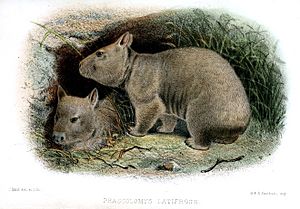
Southern hairy-nosed wombats breed when their favorite food grows the most. Their breeding depends on winter rainfall, which helps the grasses grow.
A female wombat is pregnant for about 22 days. Most babies are born in October. When a baby is born, it climbs into the pouch and holds onto a teat. It stays in the pouch for six months. By then, it weighs about 0.45 kilograms (1 pound). It will have light fur and its eyes will be open. Soon after, it leaves the pouch and starts eating grass outside. The young wombat is fully weaned (stops drinking milk) when it is one year old. It reaches its full size at three years old. This is also when it can start having its own babies.
How Southern Hairy-Nosed Wombats Communicate
Southern hairy-nosed wombats use sounds and smells to talk to each other. They don't often meet face-to-face, so they mostly use smells to communicate. When they do pass each other, they make rough, coughing noises. If they sense danger, they make a louder alarm call.
Status and Conservation
The southern hairy-nosed wombat was listed as Near Threatened by the IUCN in 2016. This means their numbers are getting low. Many groups of wombats are now separated and might not survive on their own.
Aboriginal people used to hunt wombats for food. But catching a wombat takes a lot of effort, so they were not hunted very often. Indigenous people in Australia respect the wombat. They help keep local wombat groups healthy by hunting wombats in other areas.
Some landowners have seen wombats as pests on farms. However, wombats actually use small areas of farmland. They cause less damage to the land than farming or livestock. They also cause less damage to buildings than livestock or bad weather. In fact, grass seeds grow 70% better where wombats live.
Sometimes, too many farm animals, rabbits, and wombats eating the same plants can lead to overgrazing. This means too much grass is eaten.
Overgrazing, the spread of weeds, and droughts have caused problems. The plants in some areas are now mostly annual grasses and weeds. Wombats cannot get enough food from these plants. This has led to reports of wombats becoming very thin and starving.
Competition from introduced rabbits also threatens wombats.
It is thought that wombat numbers have dropped by 70% in the last ten years. Other threats include cars, diseases like Sarcoptic mange, and starvation due to poor land management. There are no signs that their numbers will stop falling.
The Wombat Awareness Organisation is a non-profit group in the Adelaide hills. They focus on rescuing, helping, and speaking up for the Southern Hairy-nosed Wombat.
Related Pages
See also
 In Spanish: Uómbat de hocico peludo del sur para niños
In Spanish: Uómbat de hocico peludo del sur para niños



